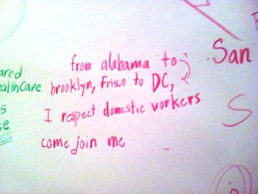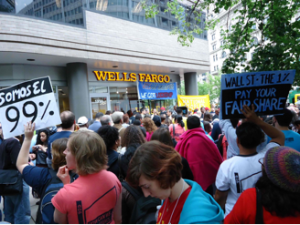Yesterday on the Rachel Maddow Show, Melissa Harris Perry, filling in for Maddow, called on viewers to join neighborhood associations or other organizations. She stated that civic faith is important among this nation’s great conributions to the world has been its distinct associational life” but in recent decades Americans’ participation in associational life has declined. “We are less likely to join bowling leagues, PTAs and even local political parties.” She cites this lack of associational connections to a decline in solidarity, trust and tolerance. Harris Perry was specifically speaking about the tragic shootings in Colorado over the weekend, but her arguments also have greater implications for traditional organizing models. Before transitioning to her comments on associations, Harris Perry was speaking about the time for “turning to faith” and prayer that many political candidates spoke of yesterday and extending this to a turning to associations. During the past few decades, not only have citizens turned away from various associations and political parties, but people have also largely turned away from places of worship. Many countries the world over, especially in Western Europe, similar reports of dwindling church attendance roll in. While many churches are shrinking, one type of church has been growing, those non-denominational churches with a distinct penchant for contemporary music and fiery oratory. These organizations are also a base for organizers on the right to organize protests on pick-your-cause. The more traditional mainline Protestant churches? Shrinking populations make for a difficult to organize base. As such, the left does not effectively use spaces of faith to organizing and create lasting change.
In contrast, groups on the right utilize faith spaces (of differing traditions) effectively to make political statements and change. Through these means these groups are able to influence the public dialogue on a topic. Examples of such are anti-choice protestors or even the Westboro Baptist church. These groups are able to serve as very effective “rubber band groups” able to shift all discourse a little further to the right and occasionally wreaking havoc in our under-participated-in electoral system. Religious groups on the left and right both run thousands of types of social programs. These can range from counseling, addiction, job training programs, shelters and even clean needle programs. These types of charity organizations have been a foundation of the American church since well before the American revolution when churches served as pillars of the community providing most education and social services within each community. Now, the power of more than half of these faith based communities has dwindled. Be it from apathy, the dissaccosiation trend the country has been experiencing or such as simple fact as disparate experiences, few religious organizations on the left have effectively organized to make lasting change on one particular cause. The selection of a cause may be a problem, but I have personally witnessed many instances of group support of an idea and a total lack of willingness on the part of any single individual to spearhead these projects.
To be sure, the Episcopal Church of America has significant strides in this respect with their programs to LGBT rights, even urging Congress to do so. But sadly, there are other churches with national and international scope committed to combating injustices similar to the Episcopal Church, but these efforts are sadly disparate. Even within the Episcopal church I have seen hundreds of different types of social programs offered, but I have only twice seen diocesan cooperation on a specific project, and in these cases the projects were handed down by bishops.
Traditionally churches and other religious institutions have served as important sites for organizing. Martin Luther King Jr. and Malcom X each had incredibly strong bases in religious communities, as have other leaders as far back at the American Revolution. Some organizations, such as many members of the National Domestic Workers Alliance, where I am working this summer, are organized from religious communities, meet in churches, or are comprised of many members of the same religious community. Can these faith spaces organize to work together and transform their influence into an effect? My priest will often bring up Episcopalians’ aversion to conversion of others due to the stigmatization associated with the aggressive tactics of fundamentalist evangelical groups, but do these desires to appear different hinder our ability to organize effectively? It seems that mainline Protestants have a lot to learn from their more conservative counterparts.



